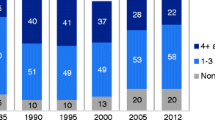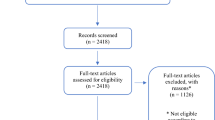Abstract
At the International Gambling Conference: Policy, Practice and Research in 2004 (Clarke, eCommunity-International Journal of Mental Health and Addiction, 3:29–40, 2005), a paper was presented which proposed key indicators of the transition from social to problem gambling and to recovery, based on a review of literature on factors leading to substance abuse. They included availability of gambling activities, lack of social and cultural empowerment, low socioeconomic status, and personal loss of control. Subsequently, a multidisciplinary team collected data on why people gamble. Four New Zealand ethnic groups (Päkehä/New Zealand European, Mäori, Pacific peoples and Asians) in South Auckland were targeted for both phases of the study. Phase 1 involved qualitative analysis of data from individual interviews and focus groups. Phase 2 surveyed 345 adults using a questionnaire developed from the first phase. From both phases, key indicators for problem gambling were similar to the indicators for substance abuse. Public health interventions such as reducing access to electronic gaming machines and empowerment of cultural groups, and a longitudinal study of the development of gambling in the community are suggested.
Similar content being viewed by others
References
Abbott, M. W. (1999). New Zealand gaming reports one-seven. Wellington, NZ: Department of Internal Affairs.
Abbott, M. W. (2001). Problem and non-problem gamblers in New Zealand: A report on Phase 2 of the 1999 national prevalence survey. Report number six of the New Zealand gaming survey. Wellington, NZ: Department of Internal Affairs.
Abbott, M. W., & Volberg, R. A. (1992). Frequent and problem gambling in New Zealand. Wellington, NZ: Department of Internal Affairs.
Abbott, M. W., & Volberg, R. A. (1999). Gambling and problem gambling in the community: An international overview and critique. Report number one of the New Zealand gaming survey. Wellington, NZ: Department of Internal Affairs.
Abbott, M. W., & Volberg, R. A. (2000). Taking the pulse on gambling and problem gambling in New Zealand: Phase 1 of the 1999 National Prevalence Survey. Report number three of the New Zealand gaming survey. Wellington, NZ: Department of Internal Affairs.
Abbott, M. W., Williams, M., & Volberg, R. A. (1999). Seven years on: A follow-up study of frequent and problem gamblers living in the community. Report number two of the New Zealand gaming survey. Wellington, NZ: Department of Internal Affairs.
Abbott, M. W., Williams, M., & Volberg, R. A. (2004). A prospective study of problem and regular non-problem gamblers living in the community. Substance Use & Misuse, 39(6), 855–884.
Adams, P. (2002). Towards a national strategy for the development of research on tobacco, alcohol, other drugs and gambling (Discussion document). Auckland, NZ: University of Auckland.
Breen, R. B., & Zimmerman, M. (2002). Rapid onset of pathological gambling in machine gamblers. Journal of Gambling Studies, 18(1), 31–43.
Brown, R., & Raeburn, J. M. (2001). Towards healthy gambling: Harm minimisation and health promotion for gambling in New Zealand. Wellington, NZ: Problem Gambling Committee.
Clarke, D. (2005). Factors leading to substance abuse and implications for gambling. eCommunity-International Journal of Mental Health and Addiction, 3(1), 29–40.
Crockford, D. N., & el-Guebaly, N. (1998). Psychiatric comorbidity in pathological gambling: A critical review. Canadian Journal of Psychiatry, 43, 43–50.
Darbyshire, P., Oster, C., & Carrig, H. (2001).The experience of pervasive loss: Children and young people living in a family where parental gambling is a problem. Journal of Gambling Studies, 17(1), 23–45.
Dickerson, M. G. (1993). Internal and external determinants of persistent gambling: Problems in generalising from one form of gambling to another. Journal of Gambling Studies, 9(3), 225–245.
DiClemente, C. C., Story, M., & Murray, K. (2000). On a roll: The process of initiation and cessation of problem gambling among adolescents. Journal of Gambling Studies, 16, 289–313.
Ellery, M., Stewart, S. H., Loba, P., & Klein, R. M. (2003). Risk-taking during video lottery terminal (VLT) play in response to alcohol challenge among pathologic and non-pathologic gamblers. Alcoholism, Clinical and Experimental Research, 27, 288.
GamblingWatch (2003). Community resource pack: Dealing with gambling in New Zealand. Hamilton, NZ: GamblingWatch.
Griffiths, M. (1999). Gambling technologies: Prospects for problem gambling. Journal of Gambling Studies, 15(3), 265–283.
Gupta, R., & Derevensky, J. (1998). Adolescent gambling behavior: A prevalence study and examination of the correlates associated with problem gambling. Journal of Gambling Studies, 14(4), 319–345.
Gupta, R., & Derevensky, J. L. (2000). Adolescents with gambling problems: From research to treatment. Journal of Gambling Studies, 16, 315–342.
Hills, A. M., & Dickerson, M. (2002). Emotion, implicit decision making and persistence at gambling. Addiction, 97, 598–602.
Hodgins, D. C. (2001). Processes of changing gambling behavior. Addictive Behaviors, 26, 121–128.
Hunter, R. (1990). Problem gambling in a gambling town: The experience of Las Vegas. Paper presented at the Eighth International Conference on Gambling and Risk Taking, London, August.
Korn, D., & Shaffer, H. (1999). Gambling and the health of the public: Adopting a public health perspective. Journal of Gambling Studies, 15, 289–365.
New Zealand Government Department of Statistics (2001). 2001 Census Report. Wellington, NZ: New Zealand Government Printing Office.
Petry, N. (2002). How treatments for pathological gambling can be informed by treatments for substance use disorders. Experimental and Clinical Psychopharmacology, 10(3), 184–192.
Potenza, M. N., Steinberg, M. A., McLaughlin, S., Wu, R., Lavelle, E. T., Wilber, M. K. et al. (2003). Characteristics of problem gamblers reporting problematic alcohol use. Alcoholism, Clinical and Experimental Research, 2, 286.
Productivity Commission (1999). Australia’s gambling industries, Report No. 10. Canberra: AusInfo. Available at http://www.pc.gov.au/.
Rankine, J., & Haigh, D. (2003). Social impacts of gambling in Manukau City. Report prepared for Manukau City Council. Manukau City, NZ: Manukau City Council.
Robson, E., Edwards, J., Smith, G., & Colman, I. (2002). Gambling decisions: An early intervention program for problem gamblers. Journal of Gambling Studies, 18, 235–239.
Shaffer, H. J., & Hall, M. N. (2002). The natural history of gambling and drinking problems among casino employees. Journal of Social Psychology, 142(4), 405–424.
Shaffer, H. J., Hall, M. N., & Vander Bilt, J. (1997). Estimating the prevalence of disordered gambling behavior in the United States and Canada: A meta-analysis. Boston, Massachusetts: Harvard Medical School Division on Addictions.
Shaffer, H. J., & Korn, D. A. (2002). Gambling and related mental disorders: A public health analysis. Annual Review of Public Health, 23, 171–212.
Slutske, W. S., Jackson, K. M., & Sher, K. J. (2003). The natural history of problem gambling from age 18 to 29. Journal of Abnormal Psychology, 112(2), 263–274.
Stewart, S. H., & Kushner, M. G. (2003). Recent research on the comorbidity of alcoholism and pathological gambling. Alcoholism, Clinical and Experimental Research, 27(2), 285–291.
Toneatto, T. (1999). Cognitive psychopathology of problem gambling. Substance Use & Misuse, 34(11), 1593–1604.
Tse, S., Abbott, M., Clarke, D., Townsend, S., Kingi, P., & Manaia, W. (2005). Examining the determinants of problem gambling. (Health Research Council of New Zealand Report for contract No. 04/069). Auckland, NZ: Auckland UniServices Ltd., University of Auckland.
Volberg, R. A. (1994). The prevalence and demographics of pathological gamblers: Implications for public health. American Journal of Public Health, 84(2), 237–241.
Volberg, R. A. (2001). When the chips are down: Problem gambling in America. New York, New York: The Century Foundation.
Volberg, R. A., & Abbott, M. W. (1994). Lifetime prevalence estimates of pathological gambling in New Zealand. International Journal of Epidemiology, 23, 976–983.
Walker, M. B. (1992). The psychology of gambling. New York, New York: Pergamon.
Welte, J. W., Barnes, G. M., Wieczorek, W. F., Tidwell, M.-C. O., & Parker, J. C. (2004). Risk factors for pathological gambling. Addictive Behaviors, 29, 323–335.
Wiebe, J., Cox, B., & Falkowski-Ham, A. (2003a). Psychological and social factors associated with problem gambling in Ontario: A one year follow-up study. Toronto, Canada: Responsible Gambling Council (Ontario).
Wiebe, J., Single, E., & Falkowski-Ham, A. (2003b). Exploring the evolution of problem gambling: A one year follow-up study. Toronto, Canada: Responsible Gambling Council (Ontario).
Wildman, R. W. (1998). Gambling: An attempt at an integration. Edmonton, Alberta, Canada: Wynne Resources.
Willans, A. (1996). Gambling—A family affair. London: Sheldon.
Winters, K. C., Stinchfield, R. D., Botzet, A., & Anderson, N. (2002). A prospective study of youth gambling behaviors. Psychology of Addictive Behaviors, 16(1), 3–9.
Winters, K. C., Stinchfield, R. D., Botzet, A., & Slutske, W. S. (2005). Pathways of youth gambling problem severity. Psychology of Addictive Behaviors, 19(1), 104–107.
Acknowledgment
The research on which this paper is based was funded by a grant from the Health Research Council of New Zealand (HRC Ref: PG03/B/01).
Author information
Authors and Affiliations
Corresponding author
Rights and permissions
About this article
Cite this article
Clarke, D., Tse, S., Abbott, M. et al. Key Indicators of the Transition from Social to Problem Gambling. Int J Ment Health Addiction 4, 247–264 (2006). https://doi.org/10.1007/s11469-006-9024-x
Received:
Revised:
Accepted:
Published:
Issue Date:
DOI: https://doi.org/10.1007/s11469-006-9024-x




